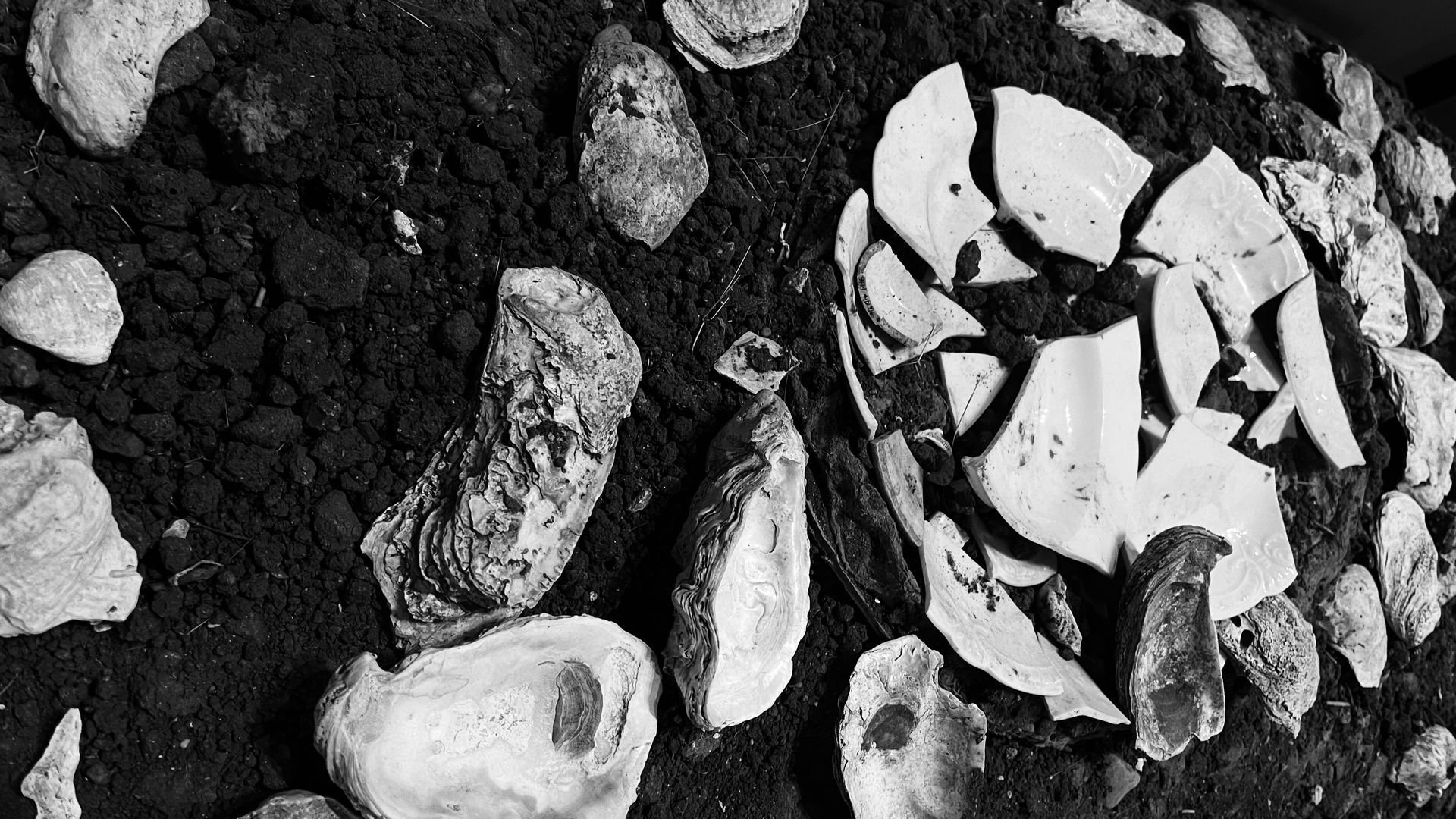The Legacy of Freedman Town

Ashley Jordan February 2025
The Root
The Akan people are an ethnic group native to Ghana and Ivory Coast. They are one of the largest ethnic groups in West Africa, with a rich history and culture. The Akan people reside primarily in Ghana's southern and central regions, including Accra. The Akan society is matrilineal, meaning descent and inheritance are traced through the female line. They have a complex system of social organization and a strong sense of community. The Akan people have significantly contributed to Ghanaian culture, particularly art, music, and spirituality. Adinkra symbols, which we discussed earlier, are a prominent example of Akan artistry. The Akan people are also known for their traditional festivals, such as the Ashanti Yam and Aboakyer festivals.
Kente
Kente cloth is a vibrant and intricate textile with deep cultural significance in Ghana. It is considered one of Africa's most celebrated and iconic fabrics, renowned for its exquisite craftsmanship and symbolic meanings.
The history of Kente cloth dates back several centuries. It is closely intertwined with the Akan people of Ghana, particularly the Ashanti and Ewe ethnic groups, during the height of the Ashanti kingdom's power. Legend has it that two brothers, Kurugu and Ameyaw, from the Bonwire village in Ashanti, were the first to create this unique fabric. They were inspired by a spider's web, observing its intricate patterns and translating them into a woven cloth. As a result, Kente became known as "Nwentoma," meaning "woven cloth of the Ashanti."
Initially, Kente cloth was exclusively worn by Ashanti royalty and associated with nobility, wealth, and prestige. Its production involved a complex and labor-intensive process requiring technical skill and artistic creativity. Various colors were obtained from natural dyes derived from plants, and each color held its symbolic meaning. For example, black represented spiritual energy, blue signified harmony, and gold symbolized wealth and royalty.
Over time, Kente cloth transcended its royal origins and became accessible to other members of society. It began to serve as a garment and a visual language, communicating cultural messages and social identities. Different patterns and motifs emerged, each carrying its symbolic significance. Some designs were reserved for specific occasions or individuals, while others conveyed broader themes such as unity, wisdom, or bravery.
In the modern era, Kente cloth has gained international recognition and appreciation. It has become a cherished African cultural heritage and identity symbol, often worn at important ceremonies and celebrations. The intricate weaving techniques and vibrant color combinations continue to captivate individuals worldwide, with contemporary artists and designers incorporating Kente-inspired elements into fashion, home decor, and other artistic expressions.
The history of Kente cloth exemplifies the resilience and creativity of the Akan people in preserving their cultural traditions. Through this iconic textile, they have not only passed down ancestral knowledge but also celebrated their heritage and contributed to the global appreciation of African artistry.
FOLKLORE
Popular folklore tells the tale of two friends, Ota and Ameyaw, who went into a forest one night to inspect their traps and were intrigued by the intricate designs of a spider web. The Spider, known in Ghanaian folklore as Ananse, offered to teach these two friends how to weave in exchange for some favors. After completing the blessings, they learned how to knit. They later went home to Bonwire (their hometown) and started practicing and committing to what they learned from Ananse, turning into silk and cotton fabrics. This lore birthed the to-be-famous artifact, the Kente.
Just to name a few among MANY remarkable individuals whose work shaped the community's cultural, economic, and educational landscape.
Dock Rowen
was a prominent entrepreneur who operated a successful grocery store and ran a real estate and loan business. In addition to selling wood and coal, Rowen was reportedly a stockholder in the founding of the State Fair of Texas in 1886. His home was located near present-day Ross Avenue, close to the intersection with Pearl Street, an area that now includes upscale apartments and retail spaces.
Abe Fuqua
A former cotton gin worker for William Caruth Sr., Fuqua became a notable landowner in Freedman Town. He owned multiple plots of land near what is now North Central Expressway and Hall Street. Fuqua’s home, an L-shaped structure, once stood near today’s Griggs Park, a space that still honors the Freedmantown legacy.
Reverend Allen R. Griggs
As the founder of New Hope Baptist Church, Reverend Griggs played a pivotal role in Freedman Town’s educational and spiritual life. His home, adjacent to the church, was located near what is now the intersection of Flora Street and Good-Latimer Expressway. This area is currently part of the Dallas Arts District.
Dr. Benjamin Bluitt:
A trailblazer in medicine, Dr. Bluitt operated one of Dallas's first Black-owned sanitariums in Deep Ellum. His residence, a two-story Victorian structure, was situated near present-day Elm Street and Good-Latimer Expressway, close to what is now a hub for entertainment and nightlife.
William Sydney Pittman
An influential architect and son-in-law of Booker T. Washington, Pittman designed several landmarks, including the St. James A.M.E. Church and the Knights of Pythias building. His Craftsman-style home was located on Good Street, now a part of the State-Thomas Historic District, which has transformed into a high-end residential and commercial area.
Reverend Henry Swann
As the pastor of St. Paul Methodist Episcopal Church, Reverend Swann led numerous educational efforts, including running a day school for local children. His home, near St. Paul’s location on Routh Street, is now part of the Uptown Dallas area, dominated by luxury high-rises and retail.
Norman W. Harllee:
A dedicated educator with a master's degree from the University of Chicago, Harllee was instrumental in advancing Black education in Freedmantown. He served as the principal of what became Booker T. Washington High School. His home was located near Flora Street and Olive Street, an area now part of the Dallas Arts District.
Alice J. Dunnegan
was a pioneering educator and civil rights advocate who founded the Dallas Women’s Club, one of the first Black women’s clubs in the city. She championed civil rights, focusing on segregation, voter disenfranchisement, and women’s suffrage. Her work empowered African American women and children in Dallas, leaving a lasting impact on the community and inspiring future generations of leaders.
Big Business
Dock Rowen’s Grocery Store and Real Estate Business
- A staple in Freedman Town's economic life, Dock Rowen provided essential goods and financial services.
- Modern Location: Near Ross Avenue and Pearl Street, now home to upscale apartments and retail shops.
Abe Fuqua’s Landholdings and Housing Ventures
- Fuqua owned and developed housing for Freedman Town residents.
- Modern Location: Near North Central Expressway and Hall Street, close to today’s Griggs Park.
Dr. Benjamin Bluitt’s Sanitarium
- One of the first Black-owned medical facilities in Dallas, offering healthcare to Freedman Town residents.
- Modern Location: Near Elm Street and Good-Latimer Expressway in the Deep Ellum district.
St. James Hotel and Lodging Businesses
- These establishments provided accommodations for Black travelers.
- Modern Location: Around Routh and Flora Streets, now part of the Dallas Arts District.
Knights of Pythias Building Businesses
- Housed offices for Black-owned law practices, insurance agencies, and event spaces.
- Modern Location: At Elm and Good Streets, formerly a vibrant community hub.
Barbershops, Salons and Tailor Shops
- These small businesses served as community centers and provided essential services.
- Modern Location: Concentrated near Griggs Park and the State-Thomas Historic District.
Church-Adjacent Markets and Stores
- Markets near churches like Free Mission Baptist provided daily necessities to residents.
- Modern Location: Around Hall Street and Cochran, an area now dominated by modern apartments.
Freedman’s Cemetery Memorial Businesses
- Businesses connected to the Freedman’s Cemetery supported burials and memorial services.
- Modern Location: Adjacent to the North Central Expressway near Lemmon Avenue.
What Remains.

The Freedman’s Cemetery, established in the 1860s by the community’s earliest settlers, served as the final resting place for countless African Americans in Freedman Town. Over time, the cemetery became a poignant symbol of the community’s perseverance and reverence for their ancestors. However, its fate was profoundly altered by urban development.
Broken plates represent broken families due to their loss.
Sea Shells to carry them back home to Africa.
Treasures from this life adorn the tops of their graves as reminders of who they were at the time of existence.
Freedman’s Cemetery is now part of Freedman’s Memorial Park, located near North Central Expressway and Lemmon Avenue. The park features sculptures, historical markers, and interpretive exhibits that pay tribute to the lives and contributions of the people interred there. Despite its transformation, the cemetery remains a vital symbol of Freedmantown’s legacy and the broader struggles of African Americans in Dallas.
This rediscovery shed light on the extent of the cemetery’s desecration and became a catalyst for efforts to honor and preserve the legacy of those buried there. Despite the recovery and relocation of some remains, it is believed that hundreds more graves remain unaccounted for due to incomplete historical records and the destruction caused by urban development.
During the highway expansion project in the late 1980s, approximately 1,500 graves were unearthed at Freedman’s Cemetery. Many of these graves had been unmarked or forgotten due to earlier construction efforts, such as the building of the North Central Expressway in the 1940s, which had already disrupted and paved over a significant portion of the cemetery.
Visit the African American Museum for a detailed Tour and Information
The City of Dallas and Urban Development in Freedman Town
The City of Dallas played a pivotal role in the urban development projects that reshaped Freedman Town, often at the expense of the African American community. These projects were driven by policies, decisions, and actions that prioritized infrastructure expansion and modernization over the preservation of historical and cultural landmarks.
Key Actions by the City of Dallas
Eminent Domain and “Blighted” Designations
- Starting in the early 20th century, the City of Dallas used eminent domain to acquire land in Freedman Town, categorizing the area as “blighted” or an “eyesore.” This designation allowed the city to displace residents under the guise of urban renewal.
- These policies disproportionately targeted Black neighborhoods, forcing many families to relocate and disrupting the social fabric of Freedman Town.
North Central Expressway Construction (1940s)
- The city collaborated with state and federal agencies to plan and construct the North Central Expressway, a major transportation artery. Freedman Town was in the direct path of this project.
- The expressway’s construction demolished homes, businesses, and community landmarks, including portions of Freedman’s Cemetery. Many graves were disturbed or paved over without adequate consultation or documentation.
Public Housing Projects
- In the 1940s, the City of Dallas approved the construction of the Roseland Homes public housing development in Freedman Town. While providing affordable housing, the project displaced numerous families and fundamentally altered the neighborhood’s character.
Urban Renewal and Redevelopment (1960s-1980s)
- During this period, the city pushed aggressive urban renewal initiatives that sought to modernize and gentrify areas near downtown Dallas. Freedman Town, now referred to as “State-Thomas” or “North Dallas,” became a focal point for redevelopment.
- The construction of the Woodall Rodgers Freeway in the 1960s dealt another blow to the community, severing connections to downtown Dallas and eliminating additional homes and businesses.
Historical Oversight
- Despite the area’s historical significance, the city failed to protect Freedman Town’s cultural heritage. The absence of preservation efforts contributed to the erasure of physical markers of the community’s past.
Key Players and Institutions Involved in Urban Development Plans
Planners and Officials
- Local planners spearheaded the designs for expressways and housing developments, often disregarding the impact on marginalized communities.
- Mayors and city council members during this time endorsed projects that prioritized economic growth and infrastructure expansion.
Texas Department of Transportation (TxDOT)
- Partnered with the city to execute highway projects, including the North Central Expressway and Woodall Rodgers Freeway, that bisected Freedman Town.
Private Developers
- Developers collaborated with the city to acquire land for redevelopment projects. These ventures transformed Freedman Town into what is now Uptown, an affluent and predominantly white area.
Consequences of Urban Development
Freedman’s Cemetery Desecration
- The city’s failure to protect Freedman’s Cemetery during the construction of the North Central Expressway caused significant cultural and historical loss.
- Rediscovered in the 1980s, the cemetery became the focus of preservation efforts led by community advocates, resulting in the establishment of Freedman’s Memorial Park.
Gentrification of State-Thomas and Uptown
- Freedman Town evolved into the State-Thomas Historic District and later Uptown, characterized by high-end apartments, retail spaces, and entertainment venues.
- This gentrification erased much of Freedman Town’s original identity and displaced many of its descendants.
Ongoing Advocacy and Commemoration
- Activists, historians, and organizations continue to highlight the injustices of urban development and advocate for preserving the remaining traces of Freedman Town.
Moving Forward: A Vision for Healing and Reconciliation
To acknowledge Freedman Town’s legacy and move forward in a way that fosters healing without victimization or condemnation, we must take intentional steps to address historical injustices while building a shared narrative. Here's how:
1. Acknowledge the Past with Honesty
- Document and Share Freedman Town’s History: Through museums, public art, digital archives, and school curricula, ensure that the story of Freedman Town is told authentically and without erasure.
- Recognize Contributions: Highlight the achievements and resilience of Freedman Town’s residents, framing their story as one of empowerment and ingenuity despite systemic oppression.
2. Invest in the Cultural Narrative
- Establish a Cultural Center: Create a dedicated space for Freedman Town’s history, featuring artifacts, oral histories, and educational programs.
- Memorialize with Public Art: Expand initiatives like Freedman’s Memorial Park with monuments, murals, or art installations to commemorate the community’s contributions and sacrifices.
- Support Black Artists and Scholars: Fund projects that explore Freedman Town’s legacy and its impact on Dallas and beyond.
3. Build Bridges Across Communities
- Community Dialogues: Host forums where residents, historians, and stakeholders can engage in conversations about Freedman Town, addressing its history, impact, and ongoing relevance.
- Partnerships Between Neighborhoods: Encourage collaboration between Uptown residents, local businesses, and community leaders to create inclusive initiatives that honor Freedman Town’s legacy.
4. Reinvest in Equity
- Affordable Housing Initiatives: Dedicate resources to housing programs that serve historically displaced families and ensure that descendants of Freedman Town’s residents have opportunities to live and thrive in Dallas.
- Economic Empowerment: Offer grants, mentorship, and spaces for Black entrepreneurs and businesses, particularly in areas historically tied to Freedman Town.
- Education and Scholarship Funds: Establish scholarships for students from historically underrepresented communities, naming them after Freedman Town’s pioneers.
5. Create Opportunities for Healing
- Intergenerational Healing Programs: Facilitate workshops and events that allow descendants of both Freedman Town residents and those connected to its displacement to share their stories and find common ground.
- Inclusive Events: Organize events like Juneteenth celebrations, cultural festivals, and historical reenactments that bring diverse communities together to celebrate Freedman Town’s legacy.
6. Foster Long-Term Accountability
- City-Led Reparative Actions: Encourage the City of Dallas to issue formal acknowledgments of harm done to Freedman Town and commit to reparative initiatives, such as funding cultural preservation or community redevelopment.
- Historical Preservation Ordinances: Implement policies to protect remaining Freedman Town landmarks and ensure that no further erasure of historical sites occurs.
A Shared Commitment
By embracing this multifaceted approach, we can honor Freedmantown without perpetuating cycles of blame or division. This path acknowledges the past while forging a future rooted in equity, collaboration, and remembrance. It is not about assigning guilt but about fostering understanding, healing, and a shared commitment to justice.
It's time for a new adventure in creativity!
Get ready to experience your newest passion.
Join a Class


